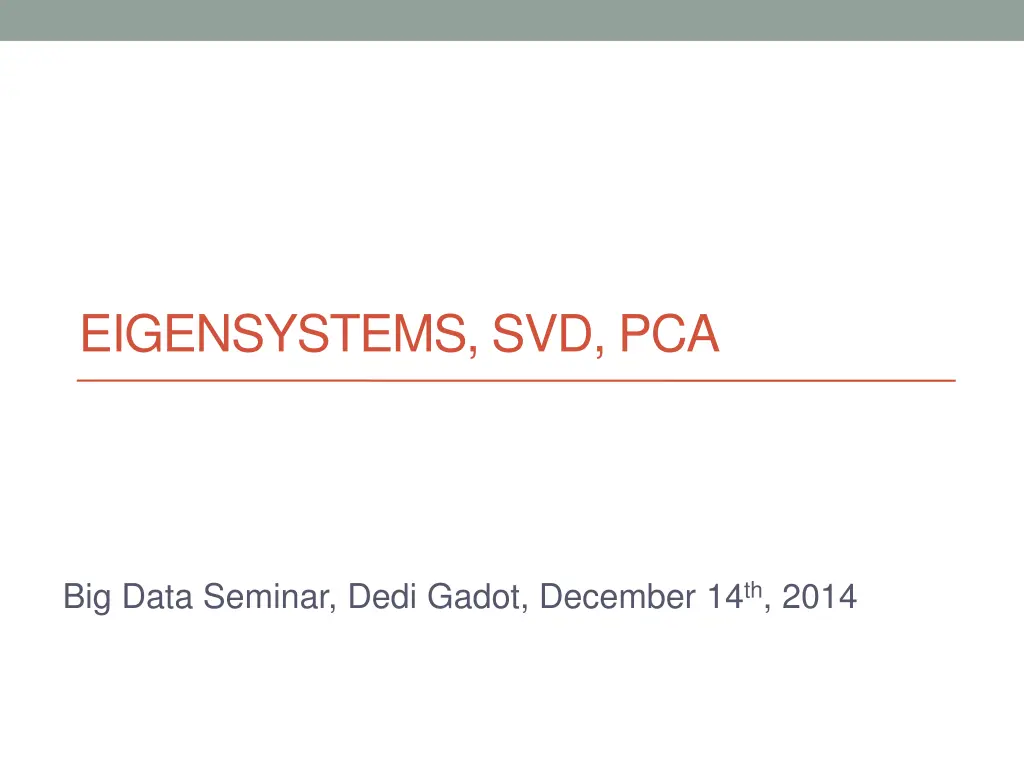
Understanding Eigenvalues, Eigenvectors, and SVD for Big Data Analysis
Learn about Eigenvalues, Eigenvectors, Singular Value Decomposition (SVD), and their applications in data analysis. Discover how these mathematical concepts play a crucial role in geometric transformations, matrix factorization, and dimensionality reduction for handling large datasets effectively.
Download Presentation

Please find below an Image/Link to download the presentation.
The content on the website is provided AS IS for your information and personal use only. It may not be sold, licensed, or shared on other websites without obtaining consent from the author. If you encounter any issues during the download, it is possible that the publisher has removed the file from their server.
You are allowed to download the files provided on this website for personal or commercial use, subject to the condition that they are used lawfully. All files are the property of their respective owners.
The content on the website is provided AS IS for your information and personal use only. It may not be sold, licensed, or shared on other websites without obtaining consent from the author.
E N D
Presentation Transcript
EIGENSYSTEMS, SVD, PCA Big Data Seminar, Dedi Gadot, December 14th, 2014
Eigvals + Eigvecs An eigenvector of a square matrix A is a non-zero vector V that when multiplied with A yields a scalar multiplication of itself by LAMBDA (the eigenvalue) ?? = ?? det ? ?? = 0 If A is a square, diagonalizable matrix ? = ? ? 1
SVD Singular Value Decomposition A factorization of a given matrix to its components: M = U V When: M an m x n real or complex matrix U an m x m unitary matrix, called the left singular vectors V an n x n unitary matrix, called the right singular vectors an m x n rectangular diagonal matrix, called the singular values
Applications and Intuition If M is a real, square matrix U,V can be referred to as rotation matrices and as a scaling matrix M = U V
Applications and Intuition The columns of U and V are orthonormal bases Singular vectors (of a square matrix) can be interpreted as the semiaxes of an ellipsoid in n-dimensional space SVD can be used to solve homogeneous linear equations Ax=0, A is a square matrix x is the right singular vector which corresponds to a singular value of A which is zero Low rank matrix approximation Take of M and leave only the r largest singular values, rebuild the matrix using U,V and you ll get a low rank approximation of M
SVD and Eigenvalues Given an SVD of M the following two relations hold: The columns of V are eigenvectors of M*M The columns of U are eigenvectors of MM* The non-zero elements of are the square roots of the non- zero eigenvalues of M*M or MM*
PCA Principal Components Analysis PCA can be thought as fitting an n-dimensional ellipsoid to the data, such that each axis of the ellipsoid represents a principal component, i.e. an axis of maximal variance
PCA X2 X1
PCA the algorithm Step A subtract the mean of each data dimension, thus move all data-points to be centered around the origin Step B calculate the covariance matrix of the data
PCA the algorithm Step C calculate the eigenvectors and the eigenvalues of the covariance matrix The eigenvectors of the covariance matrix are orthonormal (see below) The eigenvalues tell us the amount of variance of the data along each specific new dimension/axis (eigenvector)
PCA the algorithm Step D sort the eigenvalues in descending order Eigvec #1, which is correlated with Eigval #1, is the 1stprincipal component i.e. the (new) axis with highest variance Step E (optional) take only strong Principal Components Step F project the original data on the newly created base (the PCs, the eigenvectors) to get a rotated, translated coordinate system correlated with highest variance per each axis
PCA the algorithm For dimensionality reduction take only some of the new principal components to represent the data, accountable for the highest amount of variance (hence, data)
